Proper hydration is key to maintaining health, energy and cognitive function. When we exert ourselves physically or become ill, we lose fluids and electrolytes that need replenishing. Sports drinks and electrolyte beverages aim to address this need for hydration and mineral balance.
Two popular options are Pocari Sweat and Liquid I.V. But with differing ingredient profiles, flavors, costs and availability, how do you choose between them?
This comprehensive guide compares all aspects of Pocari Sweat and Liquid I.V. Read on to learn about their key similarities and differences, so you can determine which electrolyte drink may be better suited for your hydration needs and preferences.
A Brief Comparison Table
| Category | Pocari Sweat | Liquid I.V. |
| Origin | Japan | USA |
| Year launched | 1980 | 2012 |
| Main ingredients | Water, sugar, citric acid, electrolytes like Mg, Ca, NaCl, K | Water, D-ribose, citric acid, electrolytes like NaCl, KCl, MgCl2 |
| Flavors | Light citrus | Berry |
| Carbs per serving | 10g | 3g |
| Electrolytes | Moderate | High |
| Hydration capacity | Good | Excellent |
| Price per serving | Low | High |
An Overview of Pocari Sweat and Liquid I.V.
Let’s first look at the basic facts about each beverage:
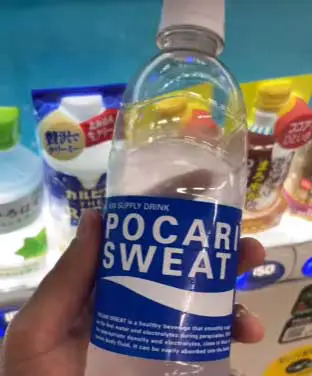
Pocari Sweat is a Japanese sports drink launched in 1980 by Otsuka Pharmaceutical Co., Ltd.
Its name comes from the concept of replenishing what is lost through sweat.
It was created as an effective hydration drink for athletes and active people.
Some key facts about Pocari Sweat:
- Created in Japan in 1980
- Manufactured by Otsuka Pharmaceutical Co., Ltd
- Available in over 30 countries globally
- Sold as a powder in individual packets or resealable tubs
- Comes in several flavors like grape, orange, lemon-lime
- Packaged in brightly-colored bags or containers
Liquid I.V. is an American electrolyte drink brand launched in 2012 by Brandin Cohen. It uses a proprietary Cellular Transport Technology designed to rapidly deliver hydration. Liquid I.V. markets itself as a superior hydration drink compared to sports beverages.
Some quick facts about Liquid I.V.:
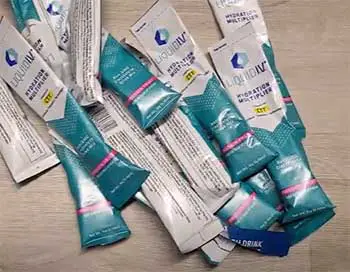
- Created in the United States in 2012
- Manufactured by Liquid I.V. LLC in El Segundo, CA
- Primarily available in North America through online sales
- Sold as powder in single-serve packets
- Comes in flavors like lemon lime, berry, passion fruit, citrus
- Packaged in minimalist yellow and black containers
Both Pocari Sweat and Liquid I.V. aim to keep the body optimally hydrated and balanced.
But Pocari Sweat takes a more traditional sports drink approach with its formula and marketing. Liquid I.V. markets itself as a cutting-edge electrolyte drink superior to mainstream sports beverages.
Now let’s do a detailed comparison across different categories:
A Side-by-Side Comparison of Ingredients
The specific ingredients and formulations used in Pocari Sweat and Liquid I.V. impact their nutritional profiles and efficacy.
Pocari Sweat’s key ingredients:
- Water – needed for hydration
- Sucrose and/or high-fructose corn syrup – for sweetness and carb energy
- Citric acid – provides tart flavor
- Magnesium carbonate – electrolyte
- Calcium chloride – electrolyte
- Sodium chloride – electrolyte
- Potassium chloride – electrolyte
Pocari Sweat uses common sports drink ingredients like sugar for carbs and a combination of electrolytes. Overall it has a straightforward formula to deliver hydration along with energy.
Liquid I.V.’s primary ingredients include:
- Water – provides hydration
- D-ribose – supports energy production
- Natural flavors – for taste
- Citric acid – gives tartness
- Stevia leaf extract – natural sweetener
- Sodium chloride – electrolyte
- Potassium chloride – electrolyte
- Magnesium chloride – electrolyte
- Zinc sulfate – essential mineral
Liquid I.V. uses more unique ingredients like D-ribose for energy metabolism and Stevia for sweetness. It also includes additional electrolytes and minerals. The formula promises faster hydration delivery.
Key differences between the drinks’ ingredients:
- Sweeteners – Pocari Sweat uses sugar while Liquid I.V. uses Stevia.
- Carbs – Pocari Sweat gets carbs from sugars while Liquid I.V. minimizes carbs.
- Extra ingredients – Liquid I.V. adds D-ribose, zinc and more electrolyte sources.
- Flavors – Pocari Sweat opts for citrus flavors while Liquid I.V. uses berry and other fruit flavors.
So while both provide electrolyte hydration, Liquid I.V.’s formula is more complex and minimizes sugar. Pocari Sweat sticks to basic sports drink ingredients including sugar.
Electrolyte Content Comparison
Electrolytes like sodium, potassium, calcium and magnesium are vital to hydration. We lose higher amounts through sweat during exercise. Replenishing them helps maintain fluid balance and muscle function.
Let’s see how Pocari Sweat and Liquid I.V. compare in their electrolyte make-up:
Pocari Sweat contains:
- Sodium
- Potassium
- Magnesium
- Calcium
It has moderate amounts of the major electrolytes needed. This helps replenish common mineral losses through perspiration and exercise.
Liquid I.V. provides higher electrolyte content with:
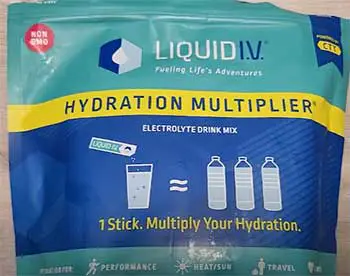
- Sodium
- Potassium
- Magnesium
- Zinc
- Chloride
By including more electrolyte sources like zinc and chloride, Liquid I.V. aims to deliver a more complete electrolyte profile compared to typical sports drinks.
In summary:
- Liquid I.V. contains significantly higher electrolyte content overall.
- It has additional trace electrolytes for fuller mineral replenishment.
- Pocari Sweat still provides adequate amounts of the most essential electrolytes like sodium and potassium.
So for serious athletes, frequent exercisers and those with high sweat losses, Liquid I.V. is likely the better choice. But Pocari Sweat can meet the needs of light to moderate exercisers.
Hydration Ability Comparison
A key goal of both drinks is to effectively rehydrate the body. Let’s examine how they stack up in terms of delivering hydration:
Pocari Sweat
- Multiple studies find it hydrates significantly better than plain water.
- It matches or exceeds other sports drinks in improving hydration markers.
- Users report feeling adequately hydrated with regular use during exercise.
So while not revolutionary, Pocari Sweat’s formula does deliver on effective hydration better than water alone.
Liquid I.V.
- Its Cellular Transport Technology is designed to enhance rapid absorption.
- The company claims up to 2-3x better hydration compared to water.
- Anecdotal reviews support fast hydration benefits during workouts and travel.
Liquid I.V. aims to offer superior hydration delivery compared to traditional sports beverages with help from its proprietary absorption technology.
In summary:
- Liquid I.V. likely hydrates faster and more efficiently, especially for serious activity.
- But Pocari Sweat still provides good hydration, meeting basic hydration needs.
- More research can help establish Liquid I.V.’s exact hydration capacity.
For quick and optimal hydration during intense exercise or heat, Liquid I.V. looks more promising. But Pocari Sweat should sufficiently hydrate for light workouts and daily needs.
Carbohydrate and Calorie Profiles
Carb and calorie content impact a drink’s energy delivery and nutritional profile.
Here is how Pocari Sweat and Liquid I.V. compare:
Pocari Sweat
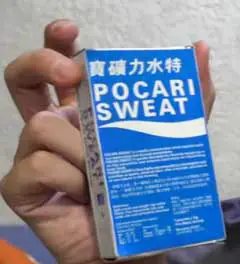
- 10 grams of carbohydrates per 8 fluid oz
- 38 calories per 8 fluid oz packet
- The sugar content provides carbs for energy.
Liquid I.V.
- 3 grams of carbohydrates per 16 fluid oz
- 10 calories per 16 fluid oz packet
- Uses Stevia instead of sugar to minimize carbs and calories.
In summary:
- Pocari Sweat has more carbs and calories from its sugar content.
- Liquid I.V. limits carbs and calories by using Stevia sweetener instead.
- Pocari Sweat can provide some energy in addition to hydration.
- Liquid I.V. offers hydration without extra carbs or calories.
So Pocari Sweat can better fit the needs of athletes desiring energy along with electrolytes. But Liquid I.V. allows hydration without unnecessary calories or carbs.
Cost Comparison of Pocari Sweat and Liquid I.V.
The price and availability of these drinks also factor into which one provides the better value and accessibility.
Pocari Sweat pricing:
- Typically $0.70 – $1.00 per 8 oz packet
- Lower cost compared to most electrolyte drinks
- Often available in multi-packs of 15+ packets
Liquid I.V. pricing:
- Approximately $1.00 – $1.50+ per 16 oz packet
- At the higher end of price for electrolyte beverages
- Sold in packs ranging from 10 to 30+ packets
Availability:
- Pocari Sweat is easily found at Asian grocery stores.
- Liquid I.V. is primarily sold online direct to consumers.
- Pocari Sweat has broader retail distribution.
In summary:
- Liquid I.V. sells at a premium cost, while Pocari Sweat is very affordable.
- Pocari Sweat can be conveniently found at local stores.
- Liquid I.V. may be worth the cost for its superior hydration benefits.
- But Pocari Sweat offers the best value for the average user.
Pocari Sweat’s lower cost and broader availability gives it the price and convenience advantage for most consumers.
How Do The Flavors compare?
Taste is an important factor affecting palatability and enjoyment. Let’s compare Pocari Sweat and Liquid I.V.’s flavor profiles:
Pocari Sweat
- Comes in citrus flavors like grapefruit, orange, lemon-lime
- Light and refreshing flavor
- Notes of sweetness and tartness
- Subtle, clean-tasting, and not overpowering
Liquid I.V.
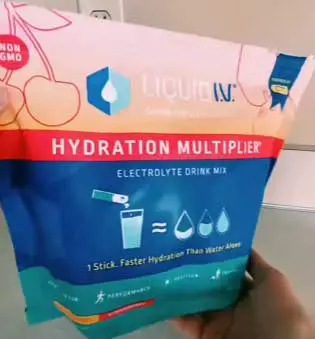
- Offered in berry, lemon lime, passionfruit and other fruit flavors
- Mild in taste, not overly sweet
- Hints of tartness
- Stevia aftertaste may not appeal to some
In summary:
- Both offer light fruit flavors that most find pleasant.
- Pocari Sweat focuses on crisp citrus flavors.
- Liquid I.V. uses more berry and tropical fruit flavors.
- Pocari Sweat may have broader appeal with its clean taste.
- But taste is personal preference.
Pocari Sweat takes a light and refreshing approach with its citrus flavors while Liquid I.V. opts for berry and tropical tastes. Ultimately taste is individual so try both to determine your favored flavor profile.
An Overall Comparison Summary
Given the similarities and differences, how do Pocari Sweat and Liquid I.V. stack up overall?
Pocari Sweat pros:
- Very affordable cost per serving
- Widely available at grocery and import stores
- Provides decent electrolyte and hydration benefits
- Clean, light and refreshing citrus taste
Liquid I.V. pros:
- Packs higher electrolyte content for serious hydration
- Proprietary technology designed for optimal absorption
- Low in sugars, carbs and calories
- Pleasant mild fruit flavors
For serious athletes and rapid rehydration, Liquid I.V. looks to be the superior choice. Its higher electrolytes, absorption technology and low carb formula benefit high exertion hydration.
For everyday hydration needs and value, Pocari Sweat delivers affordable, accessible, and tasty hydration. It sufficiently replenishes common electrolyte losses from light workouts or exercise.
The bottom line: Try both drinks to see which you prefer. But choose Liquid I.V. if your hydration needs demand more electrolytes and rapid absorption. Opt for the affordable Pocari Sweat for basic everyday hydration with a refreshing citrus taste.
Let your individual needs and preferences drive your choice between these two capable hydration beverages.
Frequently Asked Questions (FAQ)
For more insight, here are answers to some commonly asked questions:
For rapid and complete hydration, Liquid I.V. is hard to beat. Its formula delivers up to 2-3x more hydration than water. And it packs higher and more diverse electrolytes compared to mainstream sports drinks. The proprietary Cellular Transport Technology enables fast absorption.
Very few competing drinks can match these hydration benefits. DripDrop ORS and Ultima Replenisher are two products with advanced absorption technologies that may equal Liquid I.V. in efficacy. Otherwise, Liquid I.V. is likely the most effective electrolyte drink you can find for serious hydration needs.
While both hydrate better than water, Liquid I.V. provides superior hydration benefits compared to Pedialyte:
1. Liquid I.V. uses absorption technology to deliver water and electrolytes to the bloodstream faster.
2. It contains more sodium, potassium, magnesium and other electrolytes versus Pedialyte.
3. The formula has fewer sugars and carbs than Pedialyte.
Pedialyte still works well for illness recovery and moderate dehydration. But for athletic and heavy activity hydration, Liquid I.V. is likely the better performing choice.
The “healthiest” electrolyte waters offer complete electrolyte profiles without added sugars or excessive carbs:
1. Liquid I.V. – Contains high electrolyte levels and uses Stevia for minimal carbs/calories.
2. Ultima Replenisher – Sugar-free, zero carbs, and natural electrolytes.
3. Nuun Sport – Clean ingredients including magnesium and potassium with minimal sweeteners.
4. Vega Sport Electrolyte Hydrator – Stevia-sweetened, 4 grams of carbs and comprehensive electrolytes.
For a more natural option, pure coconut water contains essential electrolytes and minerals. But potency can vary by brand.
The fastest hydrating electrolyte drinks utilize rapid absorption technologies:
1. Liquid I.V. – Proprietary Cellular Transport Technology allows quick fluid and nutrient delivery.
2. DripDrop ORS – Scientifically Effective Electrolyte Infusion helps instant absorption.
3. Ultima Replenisher – Blends electrolytes and glucose for speedy hydration without calories or carbs.
4. Nuun – Fast-dissolving tablets hydrate faster than water.
While not as fast-acting, Pedialyte, Gatorade, and Powerade still hydrate quicker than plain water. But for truly rapid hydration, go with drinks with quick absorption formulations.
Wrapping Up
Here’s a quick summary comparing Pocari Sweat and Liquid I.V.:
- Pocari Sweat provides good hydration with a light citrus flavor. It contains electrolytes, sugars and carbs that help replenish what’s lost through sweat and exercise. It’s affordable and readily accessible.
- Liquid I.V. claims excellent hydration capacity with its Cellular Transport Technology. It packs higher electrolytes while being low in carbs and calories. It has a mild berry taste. But it’s costlier and less available than Pocari Sweat.
Pocari Sweat is a tasty and affordable option for everyday hydration needs. It works well after light workouts or activities.
Liquid I.V. can be worth the premium price if you need serious hydration. It outperforms Pocari Sweat when electrolyte loss is high like after intense exercise, illness or heat exposure.
Ultimately, choose the drink that best fits your budget, availability, flavor preference and hydration needs. Having both drinks on hand gives you hydration options for all occasions.
